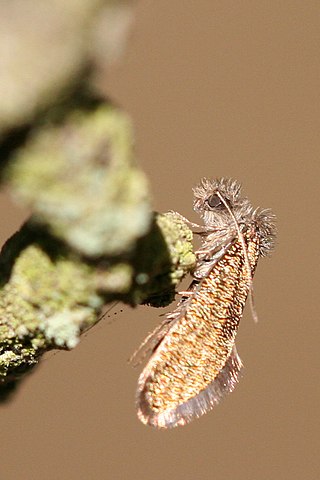
Dyseriocrania subpurpurella is a diurnal moth from the family Eriocraniidae, found in most of Europe. The moth was first named by the English entomologist, Adrian Hardy Haworth in 1828.

Eriocrania semipurpurella is a moth of the family Eriocraniidae, found from Europe to Japan and in North America. It was first described by James Francis Stephens in 1835. The species closely resembles Eriocrania sangii and the larvae of both species mine the leaves of birch.

Eriocrania sangii, the large birch purple, is a moth of the family Eriocraniidae found in Europe and described by John Henry Wood in 1891. The moth can be found flying in sunshine around birch trees and the larvae feed on birch leaves.

Eriocrania sparrmannella also known as the mottled purple is a moth of the family Eriocraniidae, found in Europe and Japan. It was first described by the French entomologist, Louis Augustin Guillaume Bosc in 1791. The specific name honours the Swedish naturalist Anders Erikson Sparrman. The larvae mine the leaves of birch.

Eriocrania chrysolepidella is a moth of the family Eriocraniidae found in Europe. It was first described by the German entomologist, Philipp Christoph Zeller in 1851. The larvae mine the leaves of hazel and hornbeam.

Parornix anglicella is a moth of the family Gracillariidae found in Asia and Europe. It was described in 1850, by the English entomologist Henry Tibbats Stainton, from a specimen from Lewisham, Kent.

Epinotia nanana, the European spruce needleminer, is a moth of the family Tortricidae. It is found from northern and central Europe to Russia and Mongolia.

Stigmella cypracma is a species of moth of the family Nepticulidae. It is endemic to New Zealand and has been observed in the North and South Islands. The larvae of this species are leaf miners and pupate within their mines. The larval host species is Brachyglottis repanda. Adult moths are on the wing in February and September to November. This species has two generations per year.

Stigmella fulva is a moth of the family Nepticulidae. It is endemic to New Zealand and has been observed in the North Island around Mount Taranaki, in the South Island and at Stewart Island. The species' eggs are laid singly but a considerable number may be deposited on the upper surface of one leaf. The incubation period can last from a week to a month depending on climatic conditions. The larvae mine the leaves of their host plants which are all in the genus Olearia. Larvae have been recorded in all months except January, February and June. The cocoon is brown and spun amongst the leaf litter under its host plant. The pupal period has been shown to range from 21 days to 79 days, again depending on climatic conditions. Adults have been observed on the wing January until March and August to December. They are active in the sun about their larval food plant.

Dyseriocrania auricyanea is a moth of the family Eriocraniidae. It was first described by Baron Walsingham in 1882 and is found in California.
Eriocraniella aurosparsella is a moth of the family Eriocraniidae. It was described by Thomas de Grey in 1880. It is found from southern Oregon south through the coastal ranges of California to Santa Clara County and Santa Cruz Island.
Eriocraniella falcata is a moth of the family Eriocraniidae. It was described by Davis in 1978. It is found in the Coast Ranges of central California.

Holocacista salutans is a moth of the family Heliozelidae. It was described by Edward Meyrick in 1921. It is found in Zimbabwe and the South African provinces of KwaZulu-Natal and Limpopo.

Pectinivalva scotodes is a moth of the family Nepticulidae. It is found in New South Wales and southern Queensland.

Charixena iridoxa, also known as the Astelia zig-zag moth, is a moth classified sometimes in the family Glyphipterigidae and sometimes in Plutellidae. It was first described by Edward Meyrick in 1916. This species is endemic to New Zealand and has been observed in the North, South and Stewart Islands. The life cycle of this moth is at least two years in length with the larvae inhabiting the bulb of its host plants and mining the underside of its leaves. These mines have a distinctive zig-zag appearance and can be easily recognised when looked for on the host plants. The larvae pupate in a cocoon attached to the leaf and this stage takes place between February and August. The adult moths emerge in the early spring and are fast, day flying moths. Their larval hosts are plants in the genus Astelia and include Astelia fragrans and Astelia nervosa.
Bucculatrix improvisa is a moth in the family Bucculatricidae. It was described by Annette Frances Braun in 1963 and is found in North America, where it has been recorded from Ohio.

Holocacista capensis is a moth of the family Heliozelidae. It was described by van Nieukerken and Geertsema in 2015. It is found in South Africa.
Filatima loowita is a moth of the family Gelechiidae. It is found in the United States, where it has been recorded from Washington.

Aspilanta argentifera is a species of moth in the family Heliozelidae, first described by Annette Frances Braun in 1927. It is found in eastern North America. The larvae are leaf miners that feed on several species of plant in the family Myricaceae.

Aspilanta voraginella is a species of moth in the family Heliozelidae, first described by Annette Frances Braun in 1927. It is found in the United States. The larvae are leaf miners that feed on Vitis arizonica.
















